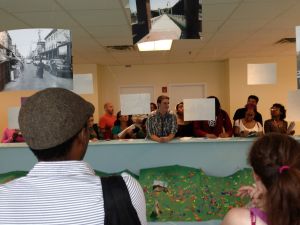
Most classrooms have bulletin boards. It’s where teachers put up exemplary work – often ten or twenty versions of the same project. And many teachers hang up projects in the hallways. We do that too, but does it go far enough? What if students and teachers treated their school as a living gallery and made more deliberate attempts to curate the school?
We didn’t set out to do that at SLA, but it’s happened. Over the past few years, students had ideas about creating murals or taking over pieces of the school to display their work. Teachers have taken entire walls to do permanent installations, and we’ve even taken over the walls of the city outside our school for art installations.

The result is that our school is slowly transforming, wall by wall, to be a showcase of the work and planning and thoughtfulness of the people of SLA. It happened because of an overwhelming desire to say yes to good ideas, rather than a deliberate attempt to say, “Every teacher must take over a 20×20 space outside their classroom,” which probably would have led to disaster.
Instead, we now have a dedicated space for a rotating gallery of student art work. We have an original mosaic of a Philadelphia cityscape hanging on the third floor. The space outside the 5th floor math lab is now filled with equations and formulas. Our hallways have original bio-wall-structures throughout them. Every year, masks from our Spanish 4 class take over the back wall of the second floor. Walls are being repurposed as canvasses. Ceiling tiles are being redesigned. It’s exciting. The school – always a colorful place – is now really becoming our own.

And now that it has happened organically, we are having to actually step back and think about what it might look like moving forward. A group of underclass students are going to take the art gallery over from the seniors who started it. Teachers and students are now beginning to collaborate on spaces more deliberately. And the school is becoming our gallery. It is exciting to watch.
And as with many things that have happened over the years, this has evolved out of a fundamental belief that students should do real things that matter and that our job, as the adults, is to support rather than to control. And as has happened in the past, we are reverse engineering some questions to ask ourselves about our public spaces as we move forward.

- What is the process by which the community changes our public spaces?
- How does this enhance the way we live in our spaces?
- Is this a permanent installation that will stay as is? Or will the space change?
- If this installation changes or needs care, who cares for it? Who curates it?
- How can we use the space as a teaching tool for ourselves? For others?
What would happen if all of us treated our schools as galleries to be co-curated by students and teachers? How might we transform the way we think about learning?

Comments are closed.